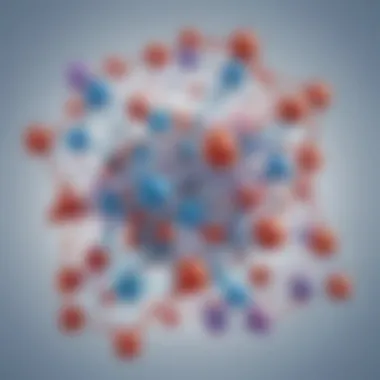Unveiling the Intricacies of State of Matter Experimentation


Fun Activities Ideas
State of matter experimentation can be an engaging and educational journey for children, parents, teachers, and guardians alike. When delving into the exploration of different matter states, incorporating fun activities can enhance the learning experience. From indoor experiments to outdoor observations, there are various ways to make the study of solids, liquids, and gases exciting and insightful.
Indoor Activities
One compelling indoor activity to explore states of matter could involve creating homemade lava lamps using household items like oil, water, and effervescent tablets. This hands-on experiment can visually demonstrate the interaction between liquids and gases, providing a tangible example of fluid dynamics.
Outdoor Adventures
Venturing outdoors opens up opportunities to explore matter transformations in a natural setting. Collecting different samples of soil, rocks, and water can spark discussions on the varying states of matter present in the environment. Observing how a puddle evaporates or how ice melts under the sun can deepen comprehension of these processes.
Arts and Crafts
Engaging in arts and crafts projects related to states of matter can blend creativity with scientific inquiry. Crafting models of molecules using beads and pipe cleaners can aid in visualizing how particles behave in solids, liquids, and gases. Additionally, creating collages showcasing different states of matter can reinforce learning through hands-on arts activities.
Science Experiments
Conducting science experiments offers a practical way to delve deeper into the implications of different matter states. Experimenting with freezing and melting points using ice cubes and heat sources can illustrate the transitions between solids and liquids. Likewise, exploring condensation by observing a glass of cold water on a warm day can provide valuable insights into gas behavior.
Cooking and Baking
Incorporating cooking and baking activities can also serve as a fun way to explore states of matter. Observing how ingredients change form during cooking processes or how dough rises through yeast fermentation can elucidate the concept of transformations in matter. From creating gaseous bread to liquid sauces, culinary experiments offer a delectable approach to understanding states of matter.
Introduction to States of Matter
In the realm of scientific inquiry, understanding the states of matter serves as the foundational cornerstone for various advancements and applications. This article embarks on a journey through the intricate landscapes of solids, liquids, and gases, illuminating their unique characteristics and behaviors. By delving into the nuances of matter states, we unlock a treasure trove of knowledge that paves the way for groundbreaking discoveries.
Defining Matter and Its Forms
Characteristics of Solids
Exploring the realm of solids unveils a world characterized by tightly packed particles exhibiting strong molecular bonds. This cohesion results in fixed shapes and volumes, distinguishing solids from other states of matter. In the context of this article, the study of characteristics of solids offers profound insights into the structural integrity and thermal conductivity of these entities. Through an in-depth analysis of bonding patterns and crystalline arrangements, we decode the secrets behind the stability and rigidity that make solids a crucial focus of scientific inquiry.


Properties of Liquids
Liquid states present a fluid and dynamic form of matter, defined by the ability of particles to move freely while maintaining proximity. The properties of liquids, such as surface tension and viscosity, play a pivotal role in various industrial and environmental processes. By emphasizing the nuances of liquid properties, this article sheds light on the significance of intermolecular forces and molecular interactions that dictate the behavior of liquids in diverse contexts. Understanding the distinctive attributes of liquids enriches our comprehension of fluid dynamics and material flow, underscoring their relevance in scientific exploration.
Behavior of Gases
The gaseous state captivates researchers with its expansive nature and high kinetic energy, showcasing behaviors distinct from solids and liquids. The behavior of gases is governed by principles of pressure, volume, and temperature, elucidating their dynamic response to external changes. Within this article, unraveling the intricacies of gas behavior unveils a realm where particles move freely and collide randomly, highlighting phenomena such as diffusion and effusion. By dissecting the behavior of gases, we unravel the adaptability and expansiveness that make gases indispensable subjects for experimentation and theoretical analysis.
Importance of Understanding Matter States
Rooted in the fabric of scientific inquiry, the importance of comprehending matter states transcends theoretical realms to impact practical applications and everyday experiences. By exploring the applications in science and industry, we witness the integration of matter states in technological innovations and product development. These applications not only enhance our understanding of matter dynamics but also propel advancements in various fields, from materials science to pharmaceutical research.
Moreover, the impact of matter states on everyday life underscores the pervasive influence of solids, liquids, and gases in our immediate surroundings. From the water we drink to the air we breathe, matter states dictate essential aspects of our existence, shaping consumer products, environmental policies, and transportation systems. An exploration of the impact on everyday life reveals the intricate interplay between matter states and human activities, emphasizing the need for a holistic understanding of these fundamental concepts.
Experimental Approaches to Studying Matter
In the realm of state of matter experimentation, the aptitude of experimental approaches plays a crucial role in unraveling the complexities of different matter states. By employing various techniques and methodologies, researchers can delve into the intricate properties and transitions that characterize solids, liquids, and gases. The significance of this topic within the context of this article lies in its ability to provide a hands-on and practical perspective, allowing for a deeper understanding of matter at a fundamental level. Through experimental approaches, scientists can directly observe and manipulate matter to uncover hidden details that might not be apparent through theoretical analyses alone.
Observational Techniques
Microscopic Examination
Microscopic examination represents a pivotal aspect of observational techniques in the study of matter. By utilizing powerful tools such as microscopes, researchers can delve into the minuscule world of particles and molecules, offering unparalleled insights into the structure and behavior of different substances. The key characteristic of microscopic examination lies in its ability to reveal intricate details at a scale invisible to the naked eye. This technique is particularly beneficial for this article as it allows for a comprehensive exploration of the molecular dynamics involved in state transitions. Despite its advantages in providing detailed imagery and analysis, microscopic examination may have limitations in terms of resolution and depth penetration, thereby requiring supplementary techniques for a holistic understanding.
Macroscopic Analysis
On the other end of the spectrum, macroscopic analysis provides a broader yet equally essential viewpoint in studying matter states. This form of observational technique focuses on the observable properties of matter on a larger scale, offering insights into bulk behaviors and characteristics. The key characteristic of macroscopic analysis lies in its capacity to delineate macroscopic properties and transitions, complementing the microscopic insights gained through detailed examination. In the context of this article, macroscopic analysis serves as a valuable tool for correlating the macroscopic behaviors of matter with their underlying microscopic structures. While macroscopic analysis excels in providing a holistic view of matter states, it may lack the granular details offered by microscopic examination, necessitating a balanced utilization of both approaches to attain a comprehensive understanding.
State Transitions and Phase Diagrams
State transitions and phase diagrams play a pivotal role in this article as we delve into the intricate realm of matter experimentation. By focusing on the specific elements of state transitions and phase diagrams, we can better grasp the fundamental principles governing the behavior of matter in different states. Understanding these transitions not only enlightens us on the properties of solids, liquids, and gases but also provides insights into how matter responds to external stimuli and changes in conditions.
Exploring the mechanisms behind state transitions offers a valuable perspective for studying the dynamic nature of matter. By examining phase diagrams, we can visualize the relationships between different states of matter and comprehend the conditions under which transitions occur. This in-depth analysis not only enhances our scientific acumen but also opens up avenues for further research and experimentation.


The benefits of delving into state transitions and phase diagrams are manifold. By uncovering the intricacies of these processes, scientists can develop new materials with tailored properties, advance technologies across various industries, and enhance our overall understanding of the natural world. Moreover, studying phase transitions can lead to breakthroughs in fields such as material science, nanotechnology, and environmental conservation.
In this article, we will explore state transitions and phase diagrams through a lens that combines theoretical knowledge with practical applications. By elucidating the significance of these concepts, we aim to provide readers with a comprehensive guide to understanding the complex behavior of matter as it undergoes transformative processes.
Applications of State of Matter Knowledge
Material Science Discoveries
Nanotechnology Innovations
Unveiling the realm of nanotechnology innovations within the context of this article unveils a horizon of possibilities. Nanotechnology offers a pioneering approach to manipulating matter on a minuscule scale, allowing for breakthroughs in materials science. The key characteristic of nanotechnology lies in its ability to engineer materials at the nanoscale, paving the way for enhanced functionalities and unprecedented material properties. This choice to include nanotechnology innovations in the discussion enriches the article by showcasing how advancements in this field can revolutionize our understanding of matter states. Despite its immense potential, nanotechnology comes with its own set of challenges, predominantly in terms of ethical implications and health concerns.
Smart Material Developments
Turning the spotlight on smart material developments within the purview of this article uncovers a domain of adaptive and responsive materials. Smart materials possess the unique characteristic of sensing and responding to external stimuli, making them a valuable asset in various applications. By accentuating the flexibility and adaptability of smart materials, this article underscores their relevance in understanding and harnessing the properties of matter states. The incorporation of smart material developments enriches the narrative by elucidating how these materials can usher in a new era of technological advancements. However, it is essential to consider the limitations and drawbacks associated with smart materials, such as their high cost and complex manufacturing processes.
Environmental Impacts and Solutions
Climate Change Mitigation
Within the broader scope of environmental impacts and solutions, honing in on climate change mitigation articulates a critical facet of applying state of matter knowledge. Addressing climate change necessitates a nuanced understanding of how different matter states interact with the environment and contribute to global warming. Emphasizing the key characteristic of climate change mitigation strategies underscores their role in combatting the adverse effects of matter state transformations on the climate. Integrating discussions on climate change mitigation enhances the article's relevance by illustrating how scientific interventions can mitigate environmental challenges. Nevertheless, potential disadvantages of certain mitigation strategies, such as financial costs and social resistance, warrant careful consideration.
Pollution Control Strategies
Exploring pollution control strategies within the context of this article unravels a tapestry of measures aimed at preserving environmental quality. Pollution control strategies encompass a diverse array of techniques designed to regulate and mitigate the impact of harmful substances on ecosystems. By spotlighting the distinctive features of pollution control strategies, this article underscores their importance in safeguarding matter states and environmental equilibrium. The integration of discussions on pollution control enriches the narrative by demonstrating how scientific approaches can address the detrimental effects of pollution on matter states. Despite their efficacy, pollution control strategies may face challenges such as resource constraints and technological limitations that merit thorough examination.
Challenges and Future Prospects
In this section of the article, we delve into the pivotal topic of Challenges and Future Prospects relating to the state of matter experimentation. Understanding the challenges faced in this field is crucial for paving the way towards future advancements and discoveries. By analyzing these challenges and contemplating future prospects, researchers can steer their focus towards innovative solutions and groundbreaking findings.
When we consider the importance of Challenges and Future Prospects within the context of this exploration, we are met with a landscape rich in opportunities for growth and development. The ability to anticipate obstacles and foresee potential avenues for progress is instrumental in shaping the course of scientific inquiry. By addressing these challenges head-on, scientists and researchers can forge new pathways for understanding the complexities of matter states and transitions.
Moreover, the benefits of delving into Challenges and Future Prospects extend far beyond the confines of conventional experimentation. By unearthing the underlying obstacles and outlining prospective directions for inquiry, we lay the groundwork for transformative discoveries that can revolutionize our comprehension of matter and its properties.


In considering specific elements of Challenges and Future Prospects, it is essential to underscore the role of critical thinking and strategic planning. By identifying key challenges and envisioning future trajectories, researchers can navigate through uncharted territory with precision and purpose. This analytical approach allows for a comprehensive assessment of the field, enabling scientists to chart a course towards profound scientific breakthroughs.
Ultimately, by embracing Challenges and Future Prospects in the realm of state of matter experimentation, we not only confront the barriers hindering our understanding but also open up a realm of infinite possibilities for scientific innovation and enlightenment.
Complex Phase Transitions
Quantum Mechanical Insights
Quantum Mechanical Insights represent a paradigm shift in the way we conceptualize and analyze phase transitions within the realm of matter experimentation. The application of quantum mechanics to the study of matter states offers a nuanced and intricate understanding of the underlying processes governing transitions between different phases.
One key characteristic of Quantum Mechanical Insights lies in their ability to delve into the fundamental quantum nature of matter, providing a microscopic view of the intricate dynamics at play during phase transitions. This depth of analysis yields insights that transcend traditional approaches, shedding light on phenomena that were previously inaccessible through classical scientific methods.
The unique feature of Quantum Mechanical Insights lies in their capacity to unravel the complex interplay of particles and energy states within matter, offering a comprehensive perspective on the behavior of substances during phase transitions. While the intricacies of quantum mechanics present challenges in their own right, the benefits of incorporating these insights into matter experimentation are manifold, laying the groundwork for groundbreaking discoveries and advancements.
Emerging Research Frontiers
Emerging Research Frontiers signify the vanguard of scientific inquiry into the realm of matter transitions and properties. By exploring novel avenues of research and venturing into uncharted territory, researchers can push the boundaries of existing knowledge and expand the horizons of state of matter experimentation.
A key characteristic of Emerging Research Frontiers is their proactive stance towards embracing innovation and exploring cutting-edge methodologies in studying matter states. This forward-thinking approach enables scientists to stay abreast of the latest developments in the field, ensuring that their research remains at the forefront of scientific advancement.
The unique feature of Emerging Research Frontiers lies in their ability to catalyze paradigm shifts and foster interdisciplinary collaborations that drive progress in matter experimentation. By pioneering new techniques and approaches, researchers can unlock new possibilities for unraveling the mysteries of matter states, paving the way for transformative discoveries and revolutionary insights.
In essence, by delving into Emerging Research Frontiers, scientists can chart new territories of knowledge, pushing the boundaries of conventional understanding and venturing into realms of discovery that promise to redefine our perception of matter and its profound intricacies.
Technological Advances in Matter Analysis
High-Resolution Imaging
High-Resolution Imaging represents a groundbreaking advancement in the realm of matter analysis, offering researchers unprecedented clarity and precision in observing the intricate details of matter states. By harnessing the power of high-resolution imaging technologies, scientists can probe into the microscopic realm of matter with unparalleled acuity and resolution.
A key characteristic of High-Resolution Imaging is its ability to capture the subtle nuances and fine structures of matter, providing a comprehensive visual representation of the intricate patterns present in different phases. This level of detail not only enhances our understanding of matter transitions but also paves the way for more accurate and insightful analyses of complex phase phenomena.
The unique feature of High-Resolution Imaging lies in its capacity to bridge the gap between theoretical models and empirical observations, offering a direct visual insight into the dynamics of matter at a fundamental level. While there are challenges associated with processing vast amounts of high-resolution data, the advantages of integrating this imaging technique into matter analysis far outweigh the potential limitations, leading to enhanced research outcomes and enriched scientific understanding.
Computational Modeling
Computational Modeling stands at the forefront of technological innovations in matter analysis, revolutionizing the way in which researchers simulate and analyze complex phase transitions. By harnessing the power of computational algorithms and simulation techniques, scientists can explore a virtually unlimited range of scenarios and parameters, providing valuable insights into the behavior of matter under varying conditions.
A key characteristic of Computational Modeling is its ability to predict and visualize the outcomes of phase transitions with remarkable accuracy and efficiency. This predictive capability enables researchers to test hypotheses, validate theories, and explore intricate dynamics that may not be easily observable through traditional experimental methods. By utilizing computational models, scientists can streamline the research process, optimize experimental designs, and unlock new possibilities for uncovering the mysteries of matter states.
The unique feature of Computational Modeling lies in its versatility and adaptability, allowing researchers to tailor simulations to specific research goals and parameters. While there are considerations regarding the computational resources required for complex modeling, the benefits of employing this approach in matter analysis are vast, offering a powerful tool for unraveling the intricacies of phase transitions and enhancing our comprehension of matter at a fundamental level.



